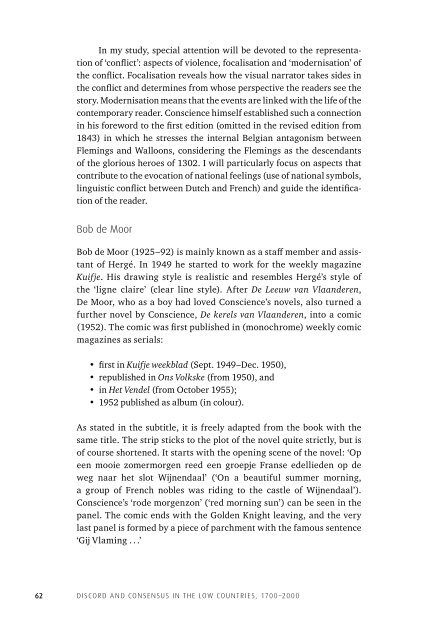Discord Consensus
7aze300jFJo
7aze300jFJo
You also want an ePaper? Increase the reach of your titles
YUMPU automatically turns print PDFs into web optimized ePapers that Google loves.
In my study, special attention will be devoted to the representation<br />
of ‘conflict’: aspects of violence, focalisation and ‘modernisation’ of<br />
the conflict. Focalisation reveals how the visual narrator takes sides in<br />
the conflict and determines from whose perspective the readers see the<br />
story. Modernisation means that the events are linked with the life of the<br />
contemporary reader. Conscience himself established such a connection<br />
in his foreword to the first edition (omitted in the revised edition from<br />
1843) in which he stresses the internal Belgian antagonism between<br />
Flemings and Walloons, considering the Flemings as the descendants<br />
of the glorious heroes of 1302. I will particularly focus on aspects that<br />
contribute to the evocation of national feelings (use of national symbols,<br />
linguistic conflict between Dutch and French) and guide the identification<br />
of the reader.<br />
Bob de Moor<br />
Bob de Moor (1925–92) is mainly known as a staff member and assistant<br />
of Hergé. In 1949 he started to work for the weekly magazine<br />
Kuifje. His drawing style is realistic and resembles Hergé’s style of<br />
the ‘ligne claire’ (clear line style). After De Leeuw van Vlaanderen,<br />
De Moor, who as a boy had loved Conscience’s novels, also turned a<br />
further novel by Conscience, De kerels van Vlaanderen, into a comic<br />
(1952). The comic was first published in (monochrome) weekly comic<br />
magazines as serials:<br />
• first in Kuifje weekblad (Sept. 1949–Dec. 1950),<br />
• republished in Ons Volkske (from 1950), and<br />
• in Het Vendel (from October 1955);<br />
• 1952 published as album (in colour).<br />
As stated in the subtitle, it is freely adapted from the book with the<br />
same title. The strip sticks to the plot of the novel quite strictly, but is<br />
of course shortened. It starts with the opening scene of the novel: ‘Op<br />
een mooie zomermorgen reed een groepje Franse edellieden op de<br />
weg naar het slot Wijnendaal’ (‘On a beautiful summer morning,<br />
a group of French nobles was riding to the castle of Wijnendaal’).<br />
Conscience’s ‘rode morgenzon’ (‘red morning sun’) can be seen in the<br />
panel. The comic ends with the Golden Knight leaving, and the very<br />
last panel is formed by a piece of parchment with the famous sentence<br />
‘Gij Vlaming . . .’<br />
62<br />
DISCORD AND CONSENSUS IN THE LOW COUNTRIES, 1700–2000


